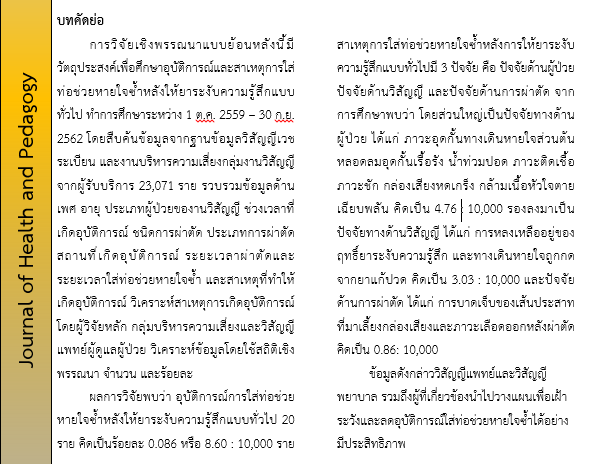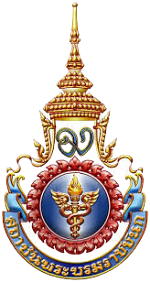อุบัติการณ์และสาเหตุการใส่ท่อช่วยหายใจซ้ำหลังการให้ยาระงับความรู้สึกแบบทั่วไปในโรงพยาบาลสงขลา
คำสำคัญ:
การใส่ท่อช่วยหายใจซ้ำ, การให้ยาระงับความรู้สึกทั่วไป, อุบัติการณ์บทคัดย่อ
การวิจัยเชิงพรรณนาแบบย้อนหลังนี้ มีวัตถุประสงค์เพื่อศึกษาอุบัติการณ์และสาเหตุการใส่ท่อช่วยหายใจซ้ำหลังให้ยาระงับความรู้สึกแบบทั่วไป ทำการศึกษาระหว่าง 1 ตุลาคม 2559 – 30 กันยายน พ.ศ. 2562 โดยสืบค้นข้อมูลจากฐานข้อมูลวิสัญญีเวชระเบียน และงานบริหารความเสี่ยงกลุ่มงานวิสัญญี จากผู้รับบริการ 23,071 ราย รวบรวมข้อมูลด้านเพศ อายุ ประเภทผู้ป่วยของานวิสัญญี ช่วงเวลาที่เกิดอุบัติการณ์ ชนิดการผ่าตัด ประเภทการผ่าตัด สถานที่เกิดอุบัติการณ์ ระยะเวลาผ่าตัดและระยะเวลาใส่ท่อช่วยหายใจซ้ำ และสาเหตุที่ทำให้เกิดอุบัติการณ์ วิเคราะห์สาเหตุการเกิดอุบัติการณ์โดยผู้วิจัยหลัก กลุ่มบริหารความเสี่ยงและวิสัญญีแพทย์ ผู้ดูแลผู้ป่วย วิเคราะห์ข้อมูลโดยใช้สถิติเชิงพรรณนา จำนวน และร้อยละ
ผลการวิจัยพบว่า อุบัติการณ์การใส่ท่อช่วยหายใจซ้ำหลังให้ยาระงับความรู้สึกแบบทั่วไป 20 ราย คิดเป็นร้อยละ 0.086 หรือ 8.60 : 10,000 ราย สาเหตุการใส่ท่อช่วยหายใจซ้ำหลังการให้ยาระงับความรู้สึกแบบทั่วไป มี 3 ปัจจัย คือ ปัจจัยด้านผู้ป่วย ด้านวิสัญญี และด้านการผ่าตัด จากการศึกษาพบว่า โดยส่วนใหญ่เป็นปัจจัยทางด้านผู้ป่วย ได้แก่ ภาวะอุดกั้นทางเดินหายใจส่วนต้น หลอดลมอุดกั้นเรื้อรัง น้ำท่วมปอด ภาวะติดเชื้อ ภาวะชัก กล่องเสียงหดเกร็ง กล้ามเนื้อหัวใจตายเฉียบพลัน คิดเป็น 4.76 : 10,000 รองลงมาเป็นปัจจัยด้านวิสัญญี ได้แก่ การหลงเหลืออยู่ของฤทธิ์ยาระงับความรู้สึก และทางเดินหายใจถูกกดจากยาแก้ปวด คิดเป็น 3.03 : 10,000 และปัจจัยด้านการผ่าตัด ได้แก่ การบาดเจ็บของเส้นประสาทที่มาเลี้ยงกล่องเสียง และภาวะเลือดออกหลังผ่าตัด คิดเป็น 0.86: 10,000
ข้อมูลดังกล่าว วิสัญญีแพทย์และวิสัญญีพยาบาล รวมถึงผู้ที่เกี่ยวข้องนำไปวางแผนเพื่อเฝ้าระวังและลดอุบัติการณ์ใส่ท่อช่วยหายใจซ้ำได้อย่างมีประสิทธิภาพ
เอกสารอ้างอิง
Bunchungmongkol, N., Pipanmekaporn, T., Punjaswadwong, Y. & Cenpakdee, S. (2009). Reintubation in the postanesthesia care unit: A retrospective study of 21,349 cases at Chiang Mai University Hospital, Thailand. Chiang Mai med Journal, 48(2), 49-55.
Charuluxananan, S., Punjasawadwong, Y., Pitimana-aree, S., Werawatganon, T., Lekprasert, V., & Nimmaanrat, S., et al. (2017). Multicentered study of anesthesia: related mortality and adverse events by incident reports in Thailand. Health Systems Research Institute, Research Report. Retrieved December 1, 2019 from http://www.hsri.or.th/research. (in Thai)
Chien, C. L., Hsun, C. S., Sheng H. L, & Cheng, Y. L. (2015). Postoperative reintubation at postanesthesia care unit from 2010 to 2011 at a teaching hospital in Taiwan. E-DA Medical Journal., 2(38-42).
Chinachoti, T., Chau-in, W., Suraseranivongse, S., Kitsampanwong, W., & Kongrit, P. (2005). Postoperative reintubation after planned extubation in Thai anesthesia incident study (Thai study). Journal of the Medical Associatation Thailand, 88(7), 84-94.
Cholitkul, S. (2012). A retrospective study the incidence of rrintubation after general anesthesia at Chiangrai Prachanukroh Hospital. Chiangrai Medical Journal, 4(1), 41-48.
Department of Anesthesioloy, Songkhla Hospital. (2020). Risk management in anesthesia (2017- 2019). Songkhla. (in Thai)
Duangngoen, P., Ittichaikulthol, W., Thamjamrassri, T., & Jiarpinitnun, J. (2016). Risk factor of reintubation in post anesthetic care unit after general anesthesia in Ramathibodi Hospital. Thai journal of Anesthesiology, 42(1), 33-41.
Junkao, J. (2011). An incidence study of risk factors related to re-intubations in the post- anesthetic care unit, Lampang Hospital. Boromarajonnani College of Nursing, Uttaradit Journal, 3(2), 12-18.
Kongsayreepong, S. (2002). Anatomy and physiology in neonatal and pediatric. In Kongsayreepong, S. & Suraseranivong, S. Anesthesia in infancy and childhood. (pp. 1-46). Bangkok: Ruenkaew Printing. (in Thai)
Luetrakool, P. (2015). Anesthesia in thyroid. In Pulnitiporn, A., Raksakietisak, M., Charoenraj, P., & Ruananukun, N. Anesthesiology. (pp. 365-374). The Royal College of Anesthesiologists of Thailand. (in Thai)
Pansamai, L. (2011). Reintubation during anesthesia in Saraburi Hospital. KM Siriraj. Retrieved November 12, 2019 from: http://www1.si.mahidol. ac.th/km/sites/default/files/95.pdf. (in Thai)
Pinsornsak, B. (2008). Incidence, causes and complications of reintubation after general anesthesia in the recovery room, Phranakhonsriayutthaya hospital. Region 4 medical journal, 10(6), 1091-1096.
Rajinda, K. (2007). The incidence of reintubation in OR and PACU following general anesthesia with endotracheal intubation at Sappasittiprasong Hospital. Khon Kaen Medical Journal, 31(1), 73-78.
Raksakietisak, M. (2015). Anesthesia for the elderly. In Pulnitiporn, A., Raksakietisak, M., Charoenraj, P., & Ruananukun, N. Anesthesiology. (pp. 207-214). The Royal College of Anesthesiologists of Thailand. (in Thai)
Rodanant, O. (2015). Postanesthetic care. In Pulnitiporn, A., Raksakietisak, M., Charoenraj, P., & Ruananukun, N. Anesthesiology. (pp. 399-409). The Royal College of Anesthesiologists of Thailand. (in Thai)
Rujirojindakul, P., Geater, A. F., Mc-Neil, E. B., Vasinanukorn, P., Prathep, S., & Asim, W., et al. (2012). Risk factors for reintubation in the post-anesthetic care unit: a case-control study. Britis Journal of Anaesthesia, 109(4), 636-642.
The Royal College of Anesthesiologists of Thailand. (2019). Guidance for anesthesia record form. Retrieved May 3, 2020 from: http://anesthai.org/public/rcat/Document. (in Thai)
Uppan, K., Jeerararuensak, W., Chau-In, W., Chairatana, L., & Promkhote, P. (2011). Anesthesia related to reintubation after planned extubation within 24 Hours after general anesthesia in Srinagarind Hospital: Incidence and risk Factors. Srinagarind Med Journal, 26(4), 325-332.
Watcharotayangul, J., Virankabutra, T., Supathada, P., & Prueksawisatesuk, W. (2020). Cuff leak test predicting upper airway obstruction and reintubation after extubation. Medicine Facaulty Rhamatibodee. Retrieved June10, 2020 from: http://Rama.Mahidol.ac.th/anest/sites/default/files/public/pdf. (in Thai)

ดาวน์โหลด
เผยแพร่แล้ว
เวอร์ชัน
- 2022-12-23 (2)
- 2022-02-07 (1)
รูปแบบการอ้างอิง
ฉบับ
ประเภทบทความ
สัญญาอนุญาต
ลิขสิทธิ์ (c) 2022 วิทยาลัยพยาบาลบรมราชชนนี นครศรีธรรมราช

อนุญาตภายใต้เงื่อนไข Creative Commons Attribution-NonCommercial-NoDerivatives 4.0 International License.
บทความที่ได้รับการตีพิมพ์เป็นลิขสิทธิ์ของ วิทยาลัยพยาบาลบรมราชชนนี นครศรีธรรมราช
ข้อความที่ปรากฏในบทความแต่ละเรื่องในวารสารวิชาการเล่มนี้เป็นความคิดเห็นส่วนตัวของผู้เขียนแต่ละท่านไม่เกี่ยวข้องกับวิทยาลัยพยาบาลบรมราชชนนี นครศรีธรรมราช และบุคคลากรท่านอื่น ๆ ในวิทยาลัยฯ แต่อย่างใด ความรับผิดชอบองค์ประกอบทั้งหมดของบทความแต่ละเรื่องเป็นของผู้เขียนแต่ละท่าน หากมีความผิดพลาดใดๆ ผู้เขียนแต่ละท่านจะรับผิดชอบบทความของตนเองแต่ผู้เดียว





